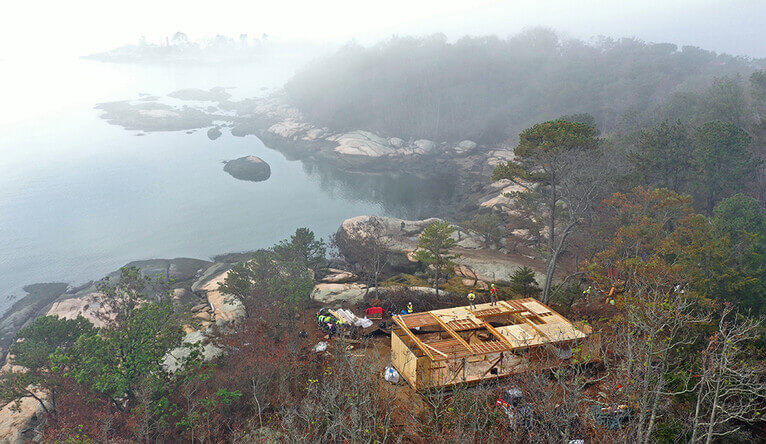Ask any architect or engineer—timber is growing (no pun intended) on everyone. The Architect’s Newspaper is excited to present TimberCon 2021, hosted in partnership with Toronto’s Mass Timber Institute to foreground exemplary projects, identify best practices for assembly, and spotlight emerging technologies within the field. A two-day event packed with leading innovators and experts, TimberCon will begin on March 18th with an address from the first keynote speaker, Alan Organschi presenting “Building a Global Carbon Sink.” His ongoing research explores the use of new wood technologies in mid-rise, high-density housing and infrastructure.
Prior to the event, AN sat down with Alan Organschi, principal of Gray Organschi Architecture and JIG Design Build (an offshoot of the firm), to discuss his work and broad substitution of emerging mass timber and bio-based building assemblies in the construction of new cityscapes.
AN: Your practice is really diverse as a professor in academia, practicing architect, and leader of material research in the field of timber as well. Can you speak about how you think the industry at large is changing?
Alan Organschi: That’s an important question. As a practitioner who gets to work with affluent clients as well as mission-based organizations, it’s a sort of symbiosis between those two things. Many of the people who will be at TimberCon may be running much larger practices, they’re building much bigger buildings than I build. And all of us, I think, run into this moment, when we face these big existential questions about our work and our role in the capacity for change and agency with each project. Then we pretty quickly start looking at bigger systems and thinking more systematically about what we do. That’s the first step. The next step is looking to partners. I really want to credit people in the manufacturing industry, who are driving the supply and demand that we’re increasingly calling upon. And there’s that middle world of really forward-thinking builders and developers who are willing to be at the bleeding edge of this thing because we see huge benefits further down the road.
We have to shift the way we demand materials. If we keep building the way we used to build, it’s a dead end. If we switch to a biomass scenario, there is a potential to start to turn building into a carbon storage system. And through that, potentially, enter into a kind of circular economic system of building, and from there start to reduce our literal, as well as emissions, footprint on the planet.
Your research posits leveraging the environmental benefits of mass timber to mitigate the projected impacts of climate change. How do you approach teaching and researching such an important and large initiative?
I would say the work of our lab is going to try to go one step further than what I previously discussed. Which is to say, first we take the Hippocratic oath: do no harm, and try to reduce and adapt. But could it be that building actually promotes ecosystem health? For example, elevating a managed forest to become healthier or more biodiverse. The potential exists if we learn how to use materials that were typically merchantable species, but can suddenly be adopted into the sort of template palette of building material. These building materials are even better and strong—because they’re weakening fast due to climate change, and land conversions, urbanization, and mineral mining. The goal is that what we take actually improves the place that we take it from, just as what we build improves the place that we build upon.
But you can’t start changing things without knowing what it is that needs to be changed. I actually think that we have the big data to do this work. I know this from the scientists I work with: we have the granular capacity to analyze the systems that we’re working in, both as manufacturers, builders, and also, as architects and engineers. So we have this big data satellite overview for our buildings in a way we haven’t in the past. We can get really specific: nail by nail, bolt by bolt, board by board, fiber by fiber. If we include material scientists, we know exactly where it’s coming from and where it’s going. And we can start to reduce the unknowns and internalize what were former economic externalities.
What projects are you currently working on and what are you excited about presenting at TimberCon 2021?
We have a lot of really, really wonderful projects ranging from organic farms, which are using waste wood to inoculate and harvest mushrooms, and producing an organic farm to table system which is on a pretty degraded industrial site in upstate New York. We’re working on a Nine Mile linear park, with landscape firms SCAPE and Fast + Epp engineering, which is going to expose and create remediation of a landscape that runs along the Hudson River, between Beacon and Cold Spring, which is a really cool project

Then on the research side, honestly, we’ve just started a new lab called the Building LAB at the Yale School of Architecture, which is a combination of design-build program, but also: experimental assemblies, working outside—ranging from indigenous materials in Indonesia to cold weather architecture on the Arctic Circle—on global sites, and continuing research with people in forestry, material science, and industrial ecology, which is a really fascinating discipline.





